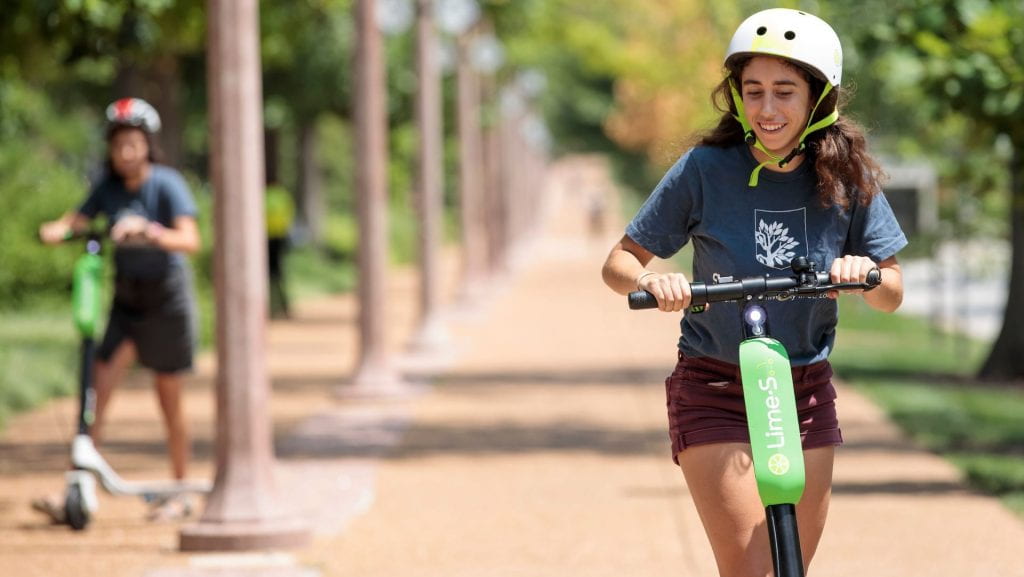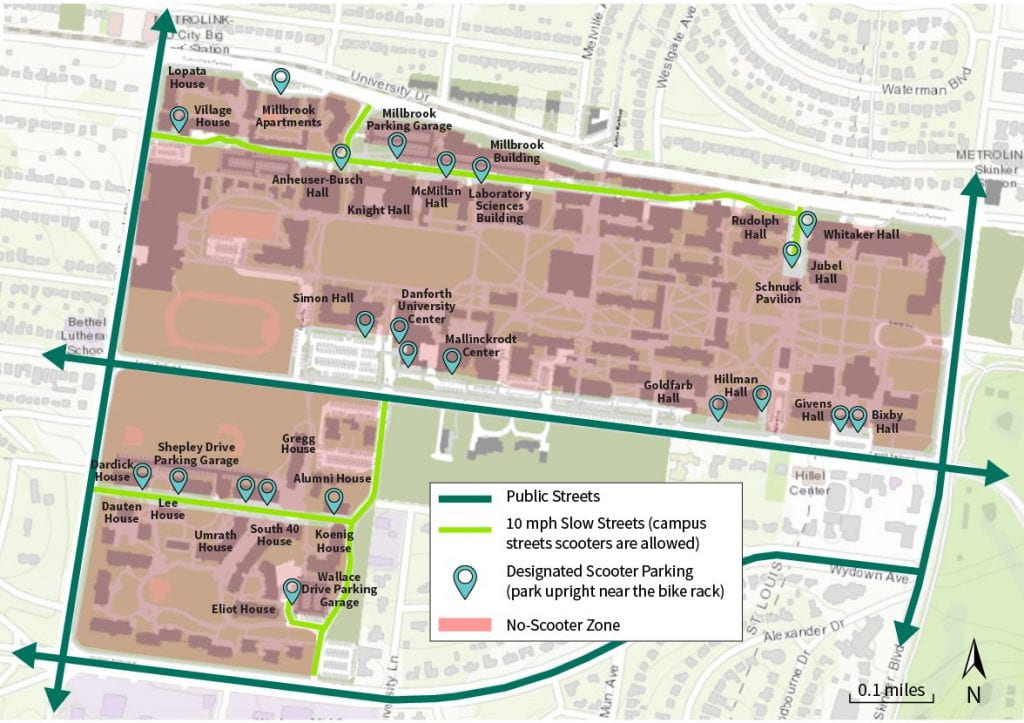It has been nearly three years since dockless shared mobility programs have taken up the streets of cities in the U.S. and around the world. In St. Louis, what started as a bike share program quickly transitioned to an exclusively e-scooter share program. Since 2019, three private companies (Lime, Bird, and Spin) have been operating dockless programs, making thousands of electric scooters available to St. Louisans for short term rentals.
After reviewing WashU’s approach to e-scooters on campus, we’ll take a look back at three years of innovative shared mobility programs and how they affect the transportation landscape, our safety, and our carbon emissions.
Electric Devices on the Danforth Campus
In the fall of 2019, in an effort to support the safety of the university community, WashU adopted a Motorized Device Policy that applies to scooters, hoverboards (self-balancing scooters/skateboards), electric skateboards (e-skateboards), Segways and similar devices.
The policy aims to ensure safe practices are being followed by motorized devices users, such as wearing a helmet, sharing the road with people walking and biking, and respecting reasonable speeds. Additionally, the policy regulates the use of scooters on campus streets to “ensure campus safety while recognizing the convenience offered by e-scooters and other devices,” said Bruce Backus, assistant vice chancellor for the Office of Environmental Health & Safety. The map below illustrates the locations where e-devices should and shouldn’t be ridden and parked on the Danforth campus.
Dockless E-Scooters in the Transportation Landscape
By flooding the streets of most major metropolitan areas, dockless shared bikes and scooters really transformed our mobility patterns. They now represent the backbone of “micromobility”, a recent term defined as transportation over short distances provided by lightweight, usually single-person vehicles.
Upon their world-wide launch in 2018, the promise of shared micromobility was to offer a strong enough alternative transportation option that it would prevent users from driving their cars, reducing traffic congestion and carbon emissions. Specifically, the hope was to provide a solution to the “first-mile/last-mile” challenge, which describes the beginning or end of an individual trip made primarily by public transportation. Users could now rent a scooter or a bike to cover the distance from home to a transit stop, which may otherwise be too long to cover on foot.
Three years into the program, we are now able to better understand the usage patterns of these devices and whether or not they are viewed as a reliable, safe, and convenient transportation mode by their users.
While research is still limited and usage patterns differ from one place to another, initial data is promising. A 2019 pilot conducted by the San Francisco’s city transportation agency found that more than a third of micromobility trips were taken to or from a transit station. Likewise, another 2019 survey by Denver Public Works found that 56% of users accessed transit with a scooter, with 19% of them doing so more than once a week.
The most telling study, conducted by the Portland Bureau of Transportation, surveyed nearly 75,000 scooter users. Its results are very encouraging, as it found that 30% of the Portlanders who responded to the survey said they most frequently used e-scooters to commute, and that in even more cases, scooters are being used to replace automobile trips. Thinking of their last e-scooter trip, 34% of Portlanders said they would have driven a personal car or hailed a taxi, Uber or Lyft.
While largely used for transportation purposes, scooters have surprisingly served as a leisure activity for many, as 28% of the PBOT survey respondents stated they most frequently used e-scooters for fun/recreation. This “joy riding” behavior is explained by “the Delight Factor”, according to a study published by SAE International. “Microvehicles offer a new mode of transportation that uniquely provides a combination of the most desired attributes of travel: freedom and control of driving, pleasantness of walking, excitement of cycling, and convenience of skateboarding.”
In their first few years of operation, dockless e-scooters have proven that they can be a reliable transportation option for people. In addition, we can hope that the increasing offer and demand for micromobility will lead to a stronger commitment from local governments to develop an infrastructure that is safe and convenient for non-vehicular transportation.
Safety Concerns of a New Technology and Road Safety
Immediately upon the launch of scooter programs around the country, safety concerns were risen by physicians and medical institutions who saw a rise in scooter-related injuries. In St. Louis, emergency room doctors demanded the mayor to convene a task force to make policy changes with the goal to protect riders. At WashU, Bruce Backus, assistant vice chancellor of environmental health and safety, was asked to lead a task force dedicated to minimizing e-scooter accidents.
The working groups are first emphasizing the importance for riders to wear helmets. Just like in biking, wearing a helmet can prevent severe head injury and be truly life-saving. A 2018 study by the University of California LA found that only 4.4% of riders were wearing a helmet when their accident occurred.
Helmets are especially important given the speed at which scooters can go. People “don’t realize that if there’s even a small incline going downhill even a couple of degrees, those 15 mile-per-hour speeds slowly build to 20 or 25 miles per hour and the slightest imperfection on a sidewalk or street can cause someone to flip,” said Bruce Backus.
The good news is that a couple of years in, we are seeing a net decrease in scooter-related injuries. Dr. Larry Lewis, a professor of emergency medicine at Washington University School of Medicine, said the university’s emergency department at Barnes-Jewish Hospital saw far less severe and frequent scooter-related injuries in 2019 than in 2018. This trend can be explained by a stabilization of the learning curve, as riders are getting more comfortable with the use of the technology.
However, while the rider’s safe behavior is critical, it’s not the only contributing factor to crashes. It appears that the condition of the streets and the road infrastructure are a big component of safety levels for micromobility users. According to a study conducted by WashU’s Dr. Larry Lewis, who asked patients who crash on scooters about the circumstances of their accidents, “more than half of the patients said road conditions caused their falls”.
Beyond the condition of the streets themselves, general road safety may be at cause. Annie YJ Chang, PhD Candidate at McGill University’s Department of Civil Engineering and Applied Mechanics, talked about a change of paradigm. “I started my PhD journey with a mission of answering the question “Are e-scooters safe?” Fast forward a year, and I am now convinced that the more appropriate question may be “Are our streets safe?””, she wrote in an article for OneZero Medium. A more recent study by the Portland Bureau of Transportation makes a similar analysis stating that bike infrastructure is key to e-scooter usage.
The Carbon Footprint of Dockless Electric Devices
While micromobility companies often present their technology as a climate no-brainer, it takes a moment to account for all the factors that contribute to the system’s carbon footprint. Researchers at North Carolina State University conducted a “life-cycle assessment” that reviewed the emissions from making, shipping, charging, collecting and disposing of scooters, and quantified the total environmental impacts associated with global warming, acidification, eutrophication, and respiratory impacts.
It appears that the impact of charging an e-scooter are insignificant in comparison with the carbon footprint of its materials and manufacturing (50% of impact), and the daily scooter collection for charging (43% of impact).
Regarding production and manufacturing, researchers assessed the environmental impacts of extracting, producing, and delivering the raw materials to build a number of parts (aluminum frame, steel parts, lithium-ion battery, and electric motor). As a result, the high production cost of the device can only be offset by a longer lifetime. However, while e-scooters’ theoretical operating life is about two years, the reality of their early years was quite different. For instance, the analysis conducted by Quartz in 2018 looked at Bird’s inaugural fleet in Louisville, KT, and found that the average scooter lasted just 28.8 days. However, past the first few months of implementation, the rate of vandalism and device misuse has significantly dropped. In addition, micromobility companies have come up with upgraded models of scooters, making them more robust, more easily reparable, and they have also implemented refurbishment and resale programs, giving scooters a second or even third life.
Fleet operation represents the second biggest impact of dockless micromobility. Though being able to hop off and leave the scooter anywhere is great for the traveler on the run, it poses a bit of a problem from an energy consumption perspective. For every scooter that is abandoned, there must be a collector driving around looking for them. It is common for these collectors to drive their personal vehicles, as they are being compensated to bring them home to charge them, in order to re-deploy them in the streets the next day. Due to the lack of optimized logistics for scooter pick-up, there is often a lot of back and forth driving, creating unneeded pollution, emissions, and traffic. To address this issue, the study recommends to use fuel-efficient vehicles for collection, to limit scooter collection to those with a low battery state of charge, and to optimize route planning for collection and distribution.
The final critical factor in assessing the environmental impact of e-scooters relates to the type of usage. The North Carolina State University study concludes that dockless scooters produce more greenhouse-gas emissions per passenger mile than a standard diesel bus with high ridership, an electric moped, an electric bicycle, or a bicycle. However, “when e-scooter usage replaces average personal automobile travel, we nearly universally realize a net reduction in environmental impacts.”
All in all, while the introduction of electric micromobility to the transportation landscape was pretty chaotic, we are already seeing significant improvements to the safety of riders and the environmental impacts of the technology. Private companies have to work hand-in-hand with city planners and transportation agencies to ensure that micromobility becomes an integrated part of the alternative transportation offering, as well as to develop a street infrastructure that is safe, comfortable, and convenient for all users, especially the most vulnerable.
Further Reading
- TREND OR FAD? Deciphering the Enablers of Micromobility in the U.S. – SAE International
- Are e-scooters polluters? The environmental impacts of shared dockless electric scooters – IOP Science
- Has Public Transit Finally Found Its First Mile-Last Mile Partner In Micromobility? – Urban Mobility Daily
- E-scooters aren’t as green as public transport — but they’re on their way – Sifted
- How St. Louis Took a Proactive Approach to E-Scooter Regulation – Next City
- Injuries Associated With Standing Electric Scooter Use – JAMA Network
- How Dangerous Are Electric Scooters? – Forbes
- St. Louis Begins Rolling Out Safety Updates For Bird, Spin And Lime Scooters – St. Louis Public Radio
- St. Louis Emergency Room Doctors Raise Concerns Over Rising Rate Of Scooter Injuries – St. Louis Public Radio
- No wheels for WU: New policy prohibits motorized scooters, skateboards – Student Life
- Are shared e-scooters good for the planet? Only if they replace car trips – Fast Company
- News Release: PBOT releases results of E-Scooter User Survey – The City of Portland Oregon
- Are Electric Scooters Awesome or Terrible? A Look at the Pros and Cons. – Entrepreneur
- Sorry, scooters aren’t so climate-friendly after all. – MIT Technology Review
- Beyond Blocking Sidewalks – SF Weekly

